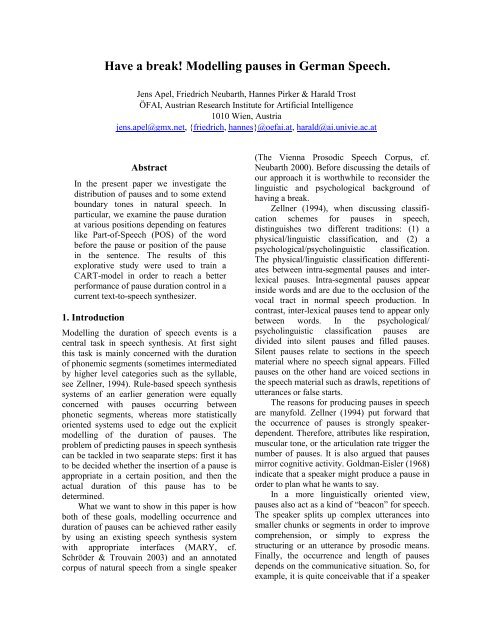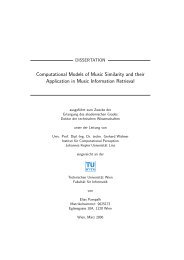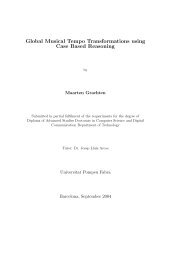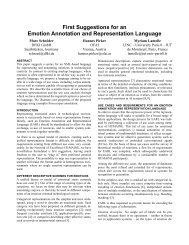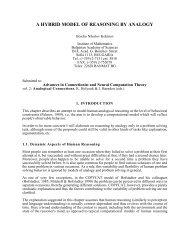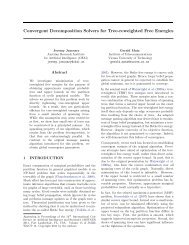Have a break! Modelling pauses in German Speech. - ResearchGate
Have a break! Modelling pauses in German Speech. - ResearchGate
Have a break! Modelling pauses in German Speech. - ResearchGate
You also want an ePaper? Increase the reach of your titles
YUMPU automatically turns print PDFs into web optimized ePapers that Google loves.
<strong>Have</strong> a <strong>break</strong>! <strong>Modell<strong>in</strong>g</strong> <strong>pauses</strong> <strong>in</strong> <strong>German</strong> <strong>Speech</strong>.<br />
Jens Apel, Friedrich Neubarth, Hannes Pirker & Harald Trost<br />
ÖFAI, Austrian Research Institute for Artificial Intelligence<br />
1010 Wien, Austria<br />
jens.apel@gmx.net, {friedrich, hannes}@oefai.at, harald@ai.univie.ac.at<br />
Abstract<br />
In the present paper we <strong>in</strong>vestigate the<br />
distribution of <strong>pauses</strong> and to some extend<br />
boundary tones <strong>in</strong> natural speech. In<br />
particular, we exam<strong>in</strong>e the pause duration<br />
at various positions depend<strong>in</strong>g on features<br />
like Part-of-<strong>Speech</strong> (POS) of the word<br />
before the pause or position of the pause<br />
<strong>in</strong> the sentence. The results of this<br />
explorative study were used to tra<strong>in</strong> a<br />
CART-model <strong>in</strong> order to reach a better<br />
performance of pause duration control <strong>in</strong> a<br />
current text-to-speech synthesizer.<br />
1. Introduction<br />
<strong>Modell<strong>in</strong>g</strong> the duration of speech events is a<br />
central task <strong>in</strong> speech synthesis. At first sight<br />
this task is ma<strong>in</strong>ly concerned with the duration<br />
of phonemic segments (sometimes <strong>in</strong>termediated<br />
by higher level categories such as the syllable,<br />
see Zellner, 1994). Rule-based speech synthesis<br />
systems of an earlier generation were equally<br />
concerned with <strong>pauses</strong> occurr<strong>in</strong>g between<br />
phonetic segments, whereas more statistically<br />
oriented systems used to edge out the explicit<br />
modell<strong>in</strong>g of the duration of <strong>pauses</strong>. The<br />
problem of predict<strong>in</strong>g <strong>pauses</strong> <strong>in</strong> speech synthesis<br />
can be tackled <strong>in</strong> two seaparate steps: first it has<br />
to be decided whether the <strong>in</strong>sertion of a pause is<br />
appropriate <strong>in</strong> a certa<strong>in</strong> position, and then the<br />
actual duration of this pause has to be<br />
determ<strong>in</strong>ed.<br />
What we want to show <strong>in</strong> this paper is how<br />
both of these goals, modell<strong>in</strong>g occurrence and<br />
duration of <strong>pauses</strong> can be achieved rather easily<br />
by us<strong>in</strong>g an exist<strong>in</strong>g speech synthesis system<br />
with appropriate <strong>in</strong>terfaces (MARY, cf.<br />
Schröder & Trouva<strong>in</strong> 2003) and an annotated<br />
corpus of natural speech from a s<strong>in</strong>gle speaker<br />
(The Vienna Prosodic <strong>Speech</strong> Corpus, cf.<br />
Neubarth 2000). Before discuss<strong>in</strong>g the details of<br />
our approach it is worthwhile to reconsider the<br />
l<strong>in</strong>guistic and psychological background of<br />
hav<strong>in</strong>g a <strong>break</strong>.<br />
Zellner (1994), when discuss<strong>in</strong>g classification<br />
schemes for <strong>pauses</strong> <strong>in</strong> speech,<br />
dist<strong>in</strong>guishes two different traditions: (1) a<br />
physical/l<strong>in</strong>guistic classification, and (2) a<br />
psychological/psychol<strong>in</strong>guistic classification.<br />
The physical/l<strong>in</strong>guistic classification differentiates<br />
between <strong>in</strong>tra-segmental <strong>pauses</strong> and <strong>in</strong>terlexical<br />
<strong>pauses</strong>. Intra-segmental <strong>pauses</strong> appear<br />
<strong>in</strong>side words and are due to the occlusion of the<br />
vocal tract <strong>in</strong> normal speech production. In<br />
contrast, <strong>in</strong>ter-lexical <strong>pauses</strong> tend to appear only<br />
between words. In the psychological/<br />
psychol<strong>in</strong>guistic classification <strong>pauses</strong> are<br />
divided <strong>in</strong>to silent <strong>pauses</strong> and filled <strong>pauses</strong>.<br />
Silent <strong>pauses</strong> relate to sections <strong>in</strong> the speech<br />
material where no speech signal appears. Filled<br />
<strong>pauses</strong> on the other hand are voiced sections <strong>in</strong><br />
the speech material such as drawls, repetitions of<br />
utterances or false starts.<br />
The reasons for produc<strong>in</strong>g <strong>pauses</strong> <strong>in</strong> speech<br />
are manyfold. Zellner (1994) put forward that<br />
the occurrence of <strong>pauses</strong> is strongly speakerdependent.<br />
Therefore, attributes like respiration,<br />
muscular tone, or the articulation rate trigger the<br />
number of <strong>pauses</strong>. It is also argued that <strong>pauses</strong><br />
mirror cognitive activity. Goldman-Eisler (1968)<br />
<strong>in</strong>dicate that a speaker might produce a pause <strong>in</strong><br />
order to plan what he wants to say.<br />
In a more l<strong>in</strong>guistically oriented view,<br />
<strong>pauses</strong> also act as a k<strong>in</strong>d of “beacon” for speech.<br />
The speaker splits up complex utterances <strong>in</strong>to<br />
smaller chunks or segments <strong>in</strong> order to improve<br />
comprehension, or simply to express the<br />
structur<strong>in</strong>g or an utterance by prosodic means.<br />
F<strong>in</strong>ally, the occurrence and length of <strong>pauses</strong><br />
depends on the communicative situation. So, for<br />
example, it is quite conceivable that if a speaker
has to perform speech <strong>in</strong> a noisy environment,<br />
she will <strong>in</strong>sert more and more significant =<br />
longer <strong>pauses</strong> and hesitations than if she has to<br />
read a text under more quiescent conditions.<br />
As just mentioned above, <strong>pauses</strong> are an<br />
imortant prosodic cue for mark<strong>in</strong>g boundaries <strong>in</strong><br />
order to improve comprehension. However, it<br />
has to be emphasised that not only <strong>pauses</strong> but<br />
also pitch changes, pre-boundary lengthen<strong>in</strong>g,<br />
decl<strong>in</strong>ation reset or <strong>in</strong>tensity shap<strong>in</strong>g are used as<br />
prosodic means for the structur<strong>in</strong>g of utterances.<br />
In a ToBI oriented approach (cf. Beckmann &<br />
Ayers 1994) all these factors are considered as<br />
physical manifestations of abstract <strong>break</strong><br />
<strong>in</strong>dices. If we th<strong>in</strong>k about prosodic structur<strong>in</strong>g,<br />
the concept of hav<strong>in</strong>g a <strong>break</strong> appears to be the<br />
more fundamental one. Therefore, beside the<br />
realisation of <strong>pauses</strong>, we will also consider the<br />
occurrence of boundary tones <strong>in</strong> the present<br />
study.<br />
2. Aims of the present study<br />
In the present study we <strong>in</strong>vestigate how <strong>in</strong>terlexical,<br />
silent <strong>pauses</strong> are distributed <strong>in</strong> natural<br />
speech. Intra-segmental <strong>pauses</strong> as a result of<br />
plosive formation as well as <strong>pauses</strong> occurr<strong>in</strong>g at<br />
the end of an utterance, which may have some<br />
significance for the higher structur<strong>in</strong>g at the<br />
textual level, are not considered here. The basis<br />
or our model is a corpus of read speech, which is<br />
compared to the <strong>pauses</strong> predicted by the MARY<br />
text-to-speech system. Apart from determ<strong>in</strong><strong>in</strong>g<br />
whether a certa<strong>in</strong> structurally determ<strong>in</strong>ed <strong>break</strong><br />
<strong>in</strong>dex is to be actually realised as a pause,<br />
special focus is put on the duration of these<br />
<strong>pauses</strong>. The crucial question is how the length of<br />
a pause depends on the surround<strong>in</strong>g structural<br />
properties, such as Part-of-<strong>Speech</strong> of the word<br />
before the pause, different punctuation signs or<br />
position of the pause <strong>in</strong> the sentence. This<br />
<strong>in</strong>formation is then used to guidel<strong>in</strong>e the<br />
automatic tra<strong>in</strong><strong>in</strong>g of a prediction-model. The<br />
ma<strong>in</strong> goal beh<strong>in</strong>d is to develop a method to<br />
improve the performance of pause control <strong>in</strong> a<br />
text-to-speech synthesizer. We <strong>in</strong>vestigate which<br />
features should be used for such a model and<br />
how it should be tra<strong>in</strong>ed to reach a good<br />
performance. We will use modell<strong>in</strong>g by the<br />
CART method on both tasks, first tra<strong>in</strong><strong>in</strong>g on a<br />
Boolean value <strong>in</strong> order to decide whether a<br />
pause has to be realised, and <strong>in</strong> a second step<br />
determ<strong>in</strong><strong>in</strong>g the duration of the pause. In the<br />
follow<strong>in</strong>g we will describe the specific<br />
components used <strong>in</strong> the present study.<br />
3. Components<br />
3.1 The Vienna prosodic speech corpus<br />
The corpus was established dur<strong>in</strong>g a project<br />
primarily concerned with the modell<strong>in</strong>g of the<br />
duration of phonetic segments. 1 It comprises<br />
approx. 50.000 phones (1.2 hours of actual<br />
speech) of Standard Austrian <strong>German</strong> spoken by<br />
a s<strong>in</strong>gle non-professional speaker. The corpus<br />
consists of 3 different types of read material for<br />
different purposes of analysis:<br />
phonetically balanced text: the classical<br />
“Nordw<strong>in</strong>d und Sonne” and<br />
“Buttergeschichte” and 300 isolated<br />
sentences<br />
material where the <strong>in</strong>formation-structure is<br />
controlled for the analysis of the relation<br />
between focus structure and prosody.<br />
22 contiguous texts from newspaper.<br />
The segmentation and annotation of phonetic<br />
labels was done semi-automatically and was also<br />
controlled manually. The corpus is also<br />
annotated for <strong>in</strong>tonation (ToBI-labels, Fujisaki<br />
accent and phrase commands), prom<strong>in</strong>ence<br />
(manual labels for each syllable) Information on<br />
l<strong>in</strong>guistic structure (feet, syllable structure, etc.)<br />
is dynamically derived and stored <strong>in</strong> the database.<br />
S<strong>in</strong>ce the corpus was designed for a slightly<br />
different purpose we could not use the full<br />
corpus for our experiments. Due to the short<br />
length of many utterances there are not always<br />
chances to have a rest, and also read<strong>in</strong>g style<br />
<strong>in</strong>hibits the <strong>in</strong>sertion of <strong>pauses</strong> as compared to<br />
for example free dialogues. After exclud<strong>in</strong>g<br />
those irrelevant samples we ended up with a<br />
subcorpus of 347 sentences with potential pause<br />
candidates actually used to tra<strong>in</strong> our models.<br />
1<br />
Segmental Duration <strong>in</strong> <strong>German</strong> <strong>Speech</strong><br />
(SpeeDurCont). This project has been sponsored by<br />
the FWF, Grant No. P13224. The Austrian Research<br />
Institute for Artificial Intelligence is supported by the<br />
Austrian Federal M<strong>in</strong>istry of Education, Science and<br />
Culture.
3.2 The MARY Text-to-<strong>Speech</strong> system<br />
<strong>Modell<strong>in</strong>g</strong> <strong>in</strong> speech synthesis requires an<br />
automatically generated structural description of<br />
an utterance. S<strong>in</strong>ce even the boundary tone<br />
labels <strong>in</strong> the Vienna Prosodic <strong>Speech</strong> Corpus are<br />
labeled manually (and therfore rely on<br />
subjective judgement) and does not conta<strong>in</strong><br />
<strong>break</strong> <strong>in</strong>dices, we have to use a different<br />
procedure <strong>in</strong> order to obta<strong>in</strong> the relevant features<br />
for modell<strong>in</strong>g. The MARY-system (Modular<br />
Architecture for Research on speech Synthesis)<br />
offers an environment perfectly suitable for this<br />
purpose. The MARY Text-to-<strong>Speech</strong> Synthesizer<br />
is a System developed at the language<br />
technology lab of the <strong>German</strong> Research Center<br />
for Artificial Intelligence (DFKI) and at the<br />
Institute of Phonetics at Saarland University. It<br />
is organised <strong>in</strong> a modular way and its <strong>in</strong>ternal<br />
markups can be accessed as XML at every stage<br />
of computation. Of particular <strong>in</strong>terest is the<br />
procedure how this system sets <strong>pauses</strong> with<strong>in</strong> a<br />
given text. The MARY system assigns three<br />
relevant <strong>in</strong>dices for potential <strong>break</strong>s (<strong>break</strong> <strong>in</strong>dex<br />
3, 4 and 6). These <strong>in</strong>dices map onto boundary<br />
tones (accord<strong>in</strong>g to the GToBI annotation<br />
scheme, cf. Grice & Baumann 2002), but they<br />
also directly correspond to <strong>pauses</strong> <strong>in</strong>serted <strong>in</strong>to<br />
the str<strong>in</strong>g of phonetic symbols. The duration of<br />
each pause category is fixed and corresponds to<br />
an empirically evaluated mean duration [(3)<br />
100ms, (4) 300ms and (6) 410ms].<br />
The relevant <strong>break</strong> <strong>in</strong>dices are selected <strong>in</strong><br />
dependency of the surround<strong>in</strong>g types of words<br />
and punctuation signs. Break <strong>in</strong>dex 3 is applied<br />
to a position <strong>in</strong> a sentence after the Vorfeld (i.e.<br />
<strong>in</strong> a matrix clause before the first f<strong>in</strong>ite verb <strong>in</strong><br />
the sentence) and before conjunctions (i.e.<br />
and/or). The rule sett<strong>in</strong>g <strong>break</strong> <strong>in</strong>dex 3 after the<br />
Vorfeld is suppressed if a personal pronoun<br />
occupies the position before the verb or if a<br />
comma is positioned after the f<strong>in</strong>ite verb. Break<br />
<strong>in</strong>dex 4 is set after punctuations like brackets,<br />
commas or quotation marks. Break <strong>in</strong>dex 6 is<br />
used only for the end of a sentence and is not of<br />
concern <strong>in</strong> this study. As for boundary tones,<br />
<strong>break</strong> <strong>in</strong>dex 3 is l<strong>in</strong>ked with the boundary tone<br />
H-, <strong>break</strong> <strong>in</strong>dex 4 with H-% and <strong>break</strong> <strong>in</strong>dex 6<br />
with boundary tone L-%. Consequently every<br />
<strong>break</strong> <strong>in</strong>dex is l<strong>in</strong>ked with both a pause and a<br />
boundary tone.<br />
Furthermore, the MARY system returns<br />
various features concern<strong>in</strong>g the words and<br />
syntax of the sentences. It returns whether the<br />
word could be retrieved from the lexicon or not<br />
(« g2p_method »), the Part-of-<strong>Speech</strong> (POS) of<br />
every word <strong>in</strong> the sentence and the syntactic<br />
attachment of every word to the previous word<br />
(syn_attach), which reflects the chunk structure<br />
of the given utterance. The <strong>break</strong> <strong>in</strong>dices, as well<br />
as the type of syntactic phrase, tones and accents<br />
are calculated on the basis of this <strong>in</strong>formation.<br />
The « g2p_method » feature (grapheme-tophoneme<br />
method) has the follow<strong>in</strong>g values :<br />
“lexicon” (i.e. the pronunciation of a word is<br />
directly retrieved from the lexicon),<br />
“compound” (i.e. pronunciation of two or more<br />
words from a lexicon are comb<strong>in</strong>ed with each<br />
other), “mtu” (multi-token unit, i.e., numbers or<br />
abbreviations are treated as whole entity) and<br />
“rules” (i.e. the pronunciation of the word is not<br />
found <strong>in</strong> the lexicon and is therefore built up by<br />
grapheme-to-phoneme rules). The « POS »<br />
feature is based on the Stuttgart/Tüb<strong>in</strong>gen<br />
Tagset (STTS, cf. Schiller et al. 1999). The<br />
« syn_attach » (syntactic attachment) has the<br />
values: ‘0’ (current item is part of the same<br />
lowest-level syn_phrase as preced<strong>in</strong>g one), ‘1’<br />
(no attachment to any previous items), ‘2’ (the<br />
current item is neither part of the present<br />
syntactic phrase nor end of it), ‘+’ (current item<br />
is attached one level higher than the preced<strong>in</strong>g<br />
one), ‘-’ (current item is attached one level lower<br />
than the preced<strong>in</strong>g one), ‘u’ (current item is<br />
attached 2 levels higher than the preced<strong>in</strong>g one)<br />
and ‘d’(current item is attached 2 levels lower<br />
than the preced<strong>in</strong>g one).<br />
In pr<strong>in</strong>ciple, the features described above<br />
are used for our tra<strong>in</strong><strong>in</strong>g of statistical models.<br />
However, the <strong>break</strong> <strong>in</strong>dices (3 and 4 be<strong>in</strong>g<br />
relevant) have a special status <strong>in</strong>sofar as they are<br />
used as primary <strong>in</strong>dicators of actual <strong>pauses</strong>. The<br />
whole architeture of our pause generation model<br />
resembles a cascaded algorithm, the first step<br />
be<strong>in</strong>g a rule based selection of candidates<br />
(correspond<strong>in</strong>g to the <strong>break</strong> <strong>in</strong>dices assigned by<br />
the MARY system), and two follow<strong>in</strong>g steps<br />
based on statistical methods: one determ<strong>in</strong><strong>in</strong>g<br />
whether a pause is realised and a second one<br />
determ<strong>in</strong><strong>in</strong>g the duration of the positively<br />
selected candidates.
4. Experimental Design<br />
With<strong>in</strong> the 347 sentences selected from the<br />
corpus the speaker actually made 350 <strong>pauses</strong><br />
with<strong>in</strong> the utterance. It has to be mentioned that<br />
the <strong>pauses</strong> <strong>in</strong> the corpus were also manually<br />
labelled. They are def<strong>in</strong>ed as the absence of any<br />
speech signal with<strong>in</strong> a subjectively determ<strong>in</strong>able<br />
span of time, not be<strong>in</strong>g related to <strong>pauses</strong> with<strong>in</strong><br />
plosive segments (<strong>in</strong>tra-segmental <strong>pauses</strong>).<br />
The same sentences were fed <strong>in</strong>to the<br />
MARY Text-to-speech system, which returned<br />
syntactic features mentioned <strong>in</strong> section 3.2.<br />
For the present experiment only those<br />
<strong>pauses</strong> were <strong>in</strong>cluded <strong>in</strong> the modell<strong>in</strong>g, which<br />
were realised both by the speaker and the<br />
MARY system. See the next section about<br />
precision and recall ratios. Impos<strong>in</strong>g this further<br />
selection on the corpus reduces the number of<br />
<strong>pauses</strong> aga<strong>in</strong> to a number of 280.<br />
This procedure was performed <strong>in</strong> order to<br />
correlate the duration of <strong>pauses</strong> produced by the<br />
speaker with features provided by the MARY<br />
system for the position of the specific pause<br />
candidate.<br />
5. Evaluation Results<br />
5.1 Match<strong>in</strong>g <strong>pauses</strong><br />
As shown <strong>in</strong> Table 1 the natural speaker made<br />
350 <strong>pauses</strong>. In contrast, the MARY system<br />
calculated 610 <strong>pauses</strong>.<br />
Pauses<br />
Tones<br />
Intersection Set union<br />
of Pauses & of <strong>pauses</strong><br />
Tones & Tones<br />
Tones<br />
without<br />
Pauses<br />
MARY-<br />
System<br />
610 610 610 610 --<br />
Natural<br />
speaker<br />
350 499 350 571 221<br />
MARY<br />
& natural<br />
speaker<br />
280 350 280 404 124<br />
set union<br />
Recall 80.00 % 70.14 % 81.29 % 70.75 % --<br />
Precision 45.90 % 57.38 % 37.05 % 66.23 % --<br />
F-score 58.33 % 63.12 % 50.90 % 68.42 % --<br />
Table 1 : Number of <strong>pauses</strong> and tones. 2<br />
2<br />
In the MARY-system prosodic phrase boundaries<br />
are always realised with both, a boundary tone and a<br />
pause. Therefore, the field «Tones without <strong>pauses</strong>»<br />
All together 280 <strong>pauses</strong> were made by both the<br />
natural speaker and the MARY system. This<br />
leads to a recall value of 80.00 %, but also to a<br />
relatively low precision rate of 45.90 %.<br />
One reason for this low precision rate lays<br />
<strong>in</strong> the fact that the MARY system does not<br />
<strong>in</strong>clude the position of a pause relative to the<br />
beg<strong>in</strong>n<strong>in</strong>g of a sentence as a dependent variable.<br />
It can be observed that the precision rate differs<br />
significantly when different regions with<strong>in</strong> the<br />
sentence are analysed separately, i.e. when<br />
<strong>pauses</strong> occur<strong>in</strong>g earlier <strong>in</strong> the sentence are<br />
dist<strong>in</strong>ghuished from those occur<strong>in</strong>g later <strong>in</strong> the<br />
sentence.<br />
Of 290 <strong>pauses</strong> set <strong>in</strong> the sentences by the<br />
MARY system before the 7 th word, only 74<br />
match with the natural speaker. In contrast, of<br />
320 <strong>pauses</strong> set by the MARY system after the 7 th<br />
word, 206 match with the natural speaker. The<br />
statistical analysis shows that these 2<br />
populations (i.e. the population of <strong>pauses</strong> before<br />
the 7 th and the population of <strong>pauses</strong> after the 7 th<br />
word <strong>in</strong> a sentence) differ significantly with<br />
p
165 candidates <strong>in</strong> this position, he realises a<br />
pause <strong>in</strong> only 24 <strong>in</strong>stances, which results <strong>in</strong> 141<br />
mismatches with the MARY system (compare<br />
Figure 2).<br />
number of items<br />
180<br />
160<br />
140<br />
120<br />
100<br />
80<br />
60<br />
40<br />
20<br />
0<br />
KON<br />
P1<br />
P2<br />
match<br />
P3<br />
P4<br />
no-match<br />
P5<br />
P6<br />
VORFELD<br />
Figure 2 : Diagram show<strong>in</strong>g the motivation for<br />
the MARY system to set a <strong>break</strong> <strong>in</strong>dex.<br />
KON = Before conjunctions; P1 = « , »;<br />
P2 = « : »; P3= « - «; P4= « ) »; P5= « ( »;<br />
P6 = «"»; VORFELD = Vorfeld;<br />
Other factors like Part-of-<strong>Speech</strong> of the word<br />
before the pause, type of syntactic phrase before<br />
the pause or the number of words after the pause<br />
did not show such clear results. On the other<br />
hand, the natural speaker <strong>in</strong>serts <strong>pauses</strong> where<br />
the MARY system does not assign a <strong>break</strong><br />
<strong>in</strong>dex. One of the reasons for these unmatched<br />
<strong>pauses</strong> is that the chunker of the MARY system<br />
does not discern between prepositional phrases<br />
directly attached to the previous noun phrase and<br />
prepositional phrases attached higher <strong>in</strong> the<br />
sentence structure. In cases where the Vorfeld is<br />
occupied by a complex phrase consist<strong>in</strong>g of a<br />
noun phrase plus additional prepositional<br />
phrases, the MARY system fails to assign a<br />
<strong>break</strong>. On the other hand, the length of the<br />
phrase <strong>in</strong> the Vorfeld encourages the natural<br />
speaker to <strong>in</strong>sert a <strong>pauses</strong> at this location.<br />
As mentioned <strong>in</strong> the <strong>in</strong>troductory section,<br />
<strong>pauses</strong> are not the only <strong>in</strong>dicator for phrase<br />
<strong>break</strong>s. Boundary tones appear even more<br />
eagerly at an abstract phrase <strong>break</strong>. For a given<br />
<strong>break</strong> <strong>in</strong>dex (higher than 3) MARY always<br />
assigns both, a boundary tone and a pause. As<br />
the data for the natural speaker shows, <strong>pauses</strong><br />
always co-occur with boundary tones. In<br />
contrast, boundary tones can stand <strong>in</strong> isolation<br />
without a pause. The data of the present study<br />
shows (see Table 1) that <strong>in</strong> addition to <strong>pauses</strong><br />
with boundary tones, the natural speaker also<br />
has boundary tones without a pause at positions<br />
where the MARY system detects a phrase <strong>break</strong>.<br />
Consequently, the F-score of the set union<br />
of <strong>pauses</strong> and tones is much better than the F-<br />
score of only <strong>pauses</strong> (68.42 % vs. 58.33%). This<br />
<strong>in</strong>dicates that the convention implied by the<br />
MARY system to <strong>in</strong>clude both a pause and a<br />
boundary tone at a phrase <strong>break</strong> is not supported<br />
by our data. Instead, <strong>in</strong> 221 cases, the natural<br />
speaker has a boundary tone without <strong>in</strong>sert<strong>in</strong>g a<br />
pause.<br />
5.2 Duration of <strong>pauses</strong><br />
Hav<strong>in</strong>g determ<strong>in</strong>ed the occurrence of a pause <strong>in</strong><br />
a given environment, the question arises how<br />
long the duration of such a pause will be. As<br />
already presented the MARY system provides<br />
<strong>in</strong>formation about various features used <strong>in</strong> the<br />
<strong>in</strong>ternal process<strong>in</strong>g. As a first step, let us analyse<br />
the environment of <strong>pauses</strong> us<strong>in</strong>g the follow<strong>in</strong>g<br />
features:<br />
- G2p-method of the word before the pause<br />
- G2p-method of the word after the pause<br />
- The POS of the word preced<strong>in</strong>g the pause<br />
- The syntactic attachment of the word<br />
preced<strong>in</strong>g the pause<br />
- The syntactic phrase preced<strong>in</strong>g the pause<br />
- The number of words preced<strong>in</strong>g the pause<br />
- The number of syllables preced<strong>in</strong>g the<br />
pause<br />
- The number of words after the pause<br />
- The motivation for the MARY system to set<br />
a <strong>break</strong> <strong>in</strong>dex<br />
In Table 2 the duration of the <strong>pauses</strong> are shown<br />
accord<strong>in</strong>g to the features listed above. The<br />
differences between the factors of the features<br />
g2p-method of the word after the pause, POS,<br />
syntactic-phrase, syntactic attachment, number<br />
of words before the pause, number of syllables<br />
before the pause and the motivation for the<br />
MARY system to set a <strong>break</strong> <strong>in</strong>dex is significant<br />
with a level of significance of p < .05 (see also<br />
Figure 3 - Figure 9).
Features Subfeatures Mean Dur / SD<br />
G2p-method<br />
(word before pause)<br />
G2p-method<br />
(word after pause)<br />
Part of <strong>Speech</strong><br />
Rules (rules)<br />
No-Rules<br />
(lexicon,mtu,<br />
compound)<br />
Rules<br />
No-Rules<br />
S1<br />
S2<br />
S3<br />
Syntactic Attachment A0 (0)<br />
A1 (1)<br />
A2 (+)<br />
A3 (-)<br />
Syntactic – Phrase Y1<br />
Y2<br />
Break <strong>in</strong>dex Break<strong>in</strong>dex 3<br />
Break<strong>in</strong>dex 4<br />
Number of words<br />
Before the pause<br />
(Position-w)<br />
Number of syllables<br />
Before the pause<br />
(Position-s)<br />
Wo 1 (=8)<br />
Sy1 (=13)<br />
322.46 ms (187.33 ms)<br />
292.22 ms (192.33 ms)<br />
177.38 ms (171.99 ms)<br />
302.26 ms (190.85 ms)<br />
387.23 ms (175.56 ms)<br />
304.46 ms (198.36 ms)<br />
237.46 ms (176.42 ms)<br />
260.39 ms (186.84 ms)<br />
335.35 ms (189.12 ms)<br />
385.12 ms (162.29 ms)<br />
199.34 ms (258.26 ms)<br />
214.47 ms (165.96 ms)<br />
335.25 ms (191.31 ms)<br />
219.00 ms (171.56 ms)<br />
307.96 ms (192.22 ms)<br />
152.69 ms (122.43 ms)<br />
242.46 ms (176.05 ms)<br />
345.98 ms (188.35 ms)<br />
168.54 ms (128.48 ms)<br />
341.20 ms (190.30 ms)<br />
N o R ules Rules<br />
Figure 3 : Boxplot of the feature « g2p-method<br />
of the word after the pause ».<br />
NoRules = lexicon, compound or mtu;<br />
Rules = transcription obta<strong>in</strong>ed by rules<br />
Number of words<br />
After the pause<br />
Motivation for the<br />
MARY system<br />
to set a pause<br />
All<br />
L7 (=24)<br />
Pu1 [ , : ) - ]<br />
Pu2 [ ( ‘ “ ]<br />
Before KON<br />
Before VORFELD<br />
275.17 ms (176.54 ms)<br />
315.55 ms (199.30 ms)<br />
315.44 ms (213.17 ms)<br />
277.23 ms (228.10 ms)<br />
326.64 ms (191.73 ms)<br />
185.92.ms (147.22 ms)<br />
311.29 ms (156.11 ms)<br />
161.31 ms (157.37 ms)<br />
295.57 ms (191.38 ms)<br />
Table 2 : Mean duration of <strong>pauses</strong> (<strong>in</strong> ms) and<br />
standard deviation.<br />
The results also show that the duration of <strong>pauses</strong><br />
for <strong>break</strong> <strong>in</strong>dex 4, which is uniformly set to<br />
300ms by MARY does not significantly differ (p<br />
= 0.26) from the duration of <strong>pauses</strong> actually<br />
produced by the natural speaker <strong>in</strong> these<br />
positions (MEAN 307.96 ms). In contrast<br />
MARY’s duration of 100ms for <strong>break</strong> <strong>in</strong>dex 3<br />
differs significantly (p < .01) from the duration<br />
of <strong>pauses</strong> the natural speaker produced (MEAN<br />
219.00 ms ).<br />
The follow<strong>in</strong>g figures illustrate the statistic<br />
distribution of duration of <strong>pauses</strong> accord<strong>in</strong>g to<br />
the selected features. All duration measurements<br />
are <strong>in</strong> ms. 3<br />
3<br />
Ad Figure 4 :<br />
S1 = {APPR,PPER,VAFIN,VAINF,VAPP,<br />
VMPP,VMFIN,VVFIN,VVINF,VVPP}<br />
S2 = {ADJD,FM,NE,PRF,PROAV,PTKVZ}<br />
S3 = {ADJA,ADV,APPRART,APZR,ART,<br />
NN,PIS,PPOSAT,VMINF}<br />
The cluster<strong>in</strong>g of the POS tags <strong>in</strong>to 3 classes was<br />
motivated heuristically by look<strong>in</strong>g at the statistic<br />
distribution of pause durations of each POS-tag.<br />
S1 S2 S3<br />
Figure 4 : Boxplot of the feature « Part-of-<br />
<strong>Speech</strong> ».<br />
Y1 Y2<br />
Figure 5 : Boxplot of the feature « Syntactic –<br />
Phrase »<br />
Y1 = {AP,AVP,CNP,NP}<br />
Y2 = {CAP,_,MPN,PP,VZ}
A 0 A 1 A 2 A 3<br />
KON P1 P2 VORFELD<br />
Figure 6 : Boxplot of the feature « syntactic<br />
attachment of the word preced<strong>in</strong>g the pause ».<br />
Pauses<br />
before the<br />
5 th word<br />
Pauses<br />
b etween<br />
the 5 th<br />
and the<br />
9 th word<br />
Pauses<br />
after the<br />
9 th word<br />
Figure 7 : Boxplot of the feature « number of<br />
words preced<strong>in</strong>g the pause ».<br />
Pauses<br />
before the<br />
13 syllable<br />
Pauses<br />
after the<br />
13 syllable<br />
Figure 8 : Boxplot of the feature « number of<br />
syllables preced<strong>in</strong>g the pause ».<br />
Figure 9 : Boxplot of the feature « motivation<br />
for the MARY system to set a <strong>break</strong> <strong>in</strong>dex »<br />
KON = Before conjunctions; P1 = { , : ) - };<br />
P2 = { ( ‘ “ }; VORFELD = ‘Vorfeld’<br />
5.3 <strong>Modell<strong>in</strong>g</strong> <strong>pauses</strong><br />
For the determ<strong>in</strong>ation whether a pause occurs <strong>in</strong><br />
a given position and the prediction of the<br />
duration of this pause we used the well known<br />
mach<strong>in</strong>e learn<strong>in</strong>g technique CART<br />
[classification and regression trees (Breiman, L.,<br />
Friedman, J., Olshen, R., and Stone, C. J.,<br />
1984)]. As tra<strong>in</strong><strong>in</strong>g data we use those sentences<br />
of the SpeeDurCont-corpus, where <strong>pauses</strong><br />
occur<strong>in</strong>g <strong>in</strong> the natural speech are also predicted<br />
by the MARY system. This data is divided<br />
randomly <strong>in</strong>to 10 equally sized subsets. Each of<br />
these subsets was used as a test sample <strong>in</strong> a 10-<br />
fold cross validation rout<strong>in</strong>e. For the evaluation<br />
of the performance of this mach<strong>in</strong>e learn<strong>in</strong>g<br />
algorithm we used the correlation value (cor)<br />
between the predicted and the orig<strong>in</strong>al values of<br />
the test sample. For tra<strong>in</strong><strong>in</strong>g and evaluation we<br />
used the CART tree package provided by the<br />
statistical tool R 4 . In a prelim<strong>in</strong>ary step the<br />
candidates for a pause (each position between<br />
two words) are filtered aga<strong>in</strong>st the criterion that<br />
a <strong>break</strong> <strong>in</strong>dex 3 or 4 is provided by the MARY<br />
algorithm. Then, the occurrence of a pause and<br />
its duration are learned.<br />
For the first part of the learn<strong>in</strong>g procedure<br />
(i.e. determ<strong>in</strong><strong>in</strong>g whether a pause occurs or not)<br />
the two features (1) Motivation for the MARY<br />
system to set a <strong>break</strong> <strong>in</strong>dex and (2) number of<br />
4<br />
R is available under the terms of the Free Software<br />
Foundation’s GNU General Public License, see:<br />
http://www.r-project.org
syllables from the beg<strong>in</strong>n<strong>in</strong>g of the sentence<br />
until the pause produce the best results (cor =<br />
0.46002). The feature “Motivation for the<br />
MARY system to set a <strong>break</strong> <strong>in</strong>dex” has the<br />
values ‘pause before conjunction’, ‘pause after<br />
Vorfeld’ and seven different punctuation signs<br />
[i.e. , - ) ( : ‘ “ ]. The feature « numbers of<br />
syllables » was pooled <strong>in</strong>to <strong>pauses</strong> before the<br />
10 th syllable and <strong>pauses</strong> after the 10 th syllable.<br />
This number was also suggested by E. Zvonik et<br />
al.(2002), as a border for the production of short<br />
(before the 10 th syllable) and longer <strong>pauses</strong> (after<br />
the 10 th syllable).<br />
In the second part of the learn<strong>in</strong>g procedure<br />
(i.e. determ<strong>in</strong>ation of the duration of a pause) we<br />
used the follow<strong>in</strong>g features (for subfeatures see<br />
Table 2):<br />
- G2p-method of the word before the pause<br />
- The syntactic attachment of the word<br />
preced<strong>in</strong>g the pause<br />
- The syntactic phrase preced<strong>in</strong>g the pause<br />
- The number of words preced<strong>in</strong>g the pause<br />
- The motivation for the MARY system to set<br />
a <strong>break</strong> <strong>in</strong>dex.<br />
This assortment of features leads to the best<br />
results with cor = 0.42. 5 Evaluat<strong>in</strong>g the results<br />
shows still a rather low correlation. Two<br />
strategies, us<strong>in</strong>g a larger corpus for the mach<strong>in</strong>e<br />
learn<strong>in</strong>g technique and reth<strong>in</strong>k<strong>in</strong>g of the features<br />
used for tra<strong>in</strong><strong>in</strong>g may be applied <strong>in</strong> future<br />
research <strong>in</strong> order to arrive at higher correlation<br />
values.<br />
5. Conclusion<br />
In the present study we evaluated the occurrence<br />
of <strong>pauses</strong> and the length of <strong>pauses</strong> made by a<br />
natural speaker aga<strong>in</strong>st a current speechsynthesizer<br />
(MARY). In comparison to the<br />
MARY system, the natural speaker realises<br />
significantly fewer <strong>pauses</strong> at prosodic phrase<br />
5<br />
When compar<strong>in</strong>g these results with correlation<br />
coefficents usually achieved when us<strong>in</strong>g similar<br />
techniques to the prediction of the duration of<br />
phonetic segments the result seems rather poor. But it<br />
has to be kept <strong>in</strong> m<strong>in</strong>d, that there are much fewer<br />
tra<strong>in</strong>ung-samples <strong>in</strong> this case, and that the durarion of<br />
<strong>pauses</strong> displays a much higher variance than a<br />
speech-sound with its clear limitations on m<strong>in</strong>imal<br />
and maximal <strong>in</strong>herent duration.<br />
boundaries, and rather relies on prosodic means<br />
like f<strong>in</strong>al lengthen<strong>in</strong>g and boundary tones.<br />
Though these results <strong>in</strong>dicate that the<br />
speech synthesis system uses <strong>pauses</strong> to a much<br />
greater extent than the natural speaker, it will be<br />
necessary to perform perception experiments <strong>in</strong><br />
order to evaluate if and <strong>in</strong> which contexts this<br />
additional redundancy <strong>in</strong> MARY’s current<br />
sett<strong>in</strong>g is to be avoided.<br />
Furthermore, we have shown that the<br />
natural speaker makes significant differences <strong>in</strong><br />
pause duration depend<strong>in</strong>g on the surround<strong>in</strong>g<br />
environment. We used this data for tra<strong>in</strong><strong>in</strong>g a<br />
CART-based predictor for pause durations.<br />
Us<strong>in</strong>g this method, we were able to set very f<strong>in</strong>e<br />
graded <strong>pauses</strong> accord<strong>in</strong>g to the structural<br />
environment the pause would occur <strong>in</strong>.<br />
References<br />
Beckman, M. E., Ayers, G. M. Guidel<strong>in</strong>es for ToBI<br />
Labell<strong>in</strong>g. Onl<strong>in</strong>e MS and accompany<strong>in</strong>g files,<br />
1994. Available at:<br />
http://www.l<strong>in</strong>g.ohio-state.edu/phonetics/E_ToBI<br />
Breiman, L., Friedman, J., Olshen, R., and Stone,<br />
C. J., Classification and Regression Trees,<br />
Chapman and Hall, New York, 1984.<br />
Goldman-Eisler, Psychol<strong>in</strong>guistics: Experiments <strong>in</strong><br />
spontaneous speech. NY: Academic Press. 1968.<br />
Grice, Mart<strong>in</strong>e, Baumann, S., “Deutsche Intonation<br />
und GToBI.” L<strong>in</strong>guistische Berichte 191, pp. 267-<br />
298, 2002.<br />
Neubarth F., Alter K., Pirker H., Rieder E., Trost H.:<br />
“The Vienna Prosodic <strong>Speech</strong> Corpus: Purpose,<br />
Content and Encod<strong>in</strong>g,” <strong>in</strong> Zuehlke W. et al. (eds.),<br />
Konvens 2000 – Sprachkommunikation, VDE<br />
Verlag, Berl<strong>in</strong>, pp.191-96, 2000.<br />
Schröder, Mark, Trouva<strong>in</strong>, Jürgen: “The <strong>German</strong><br />
Text-to-<strong>Speech</strong> Synthesis System MARY: A Tool<br />
for Research, Development and Teach<strong>in</strong>g,”<br />
International Journal of <strong>Speech</strong> Technology, (6)<br />
pp. 365-377, 2003.<br />
Schiller, A., Teufel, S., Stöckert, C., Thielen, C.<br />
Guidel<strong>in</strong>es für das Tagg<strong>in</strong>g deutscher Textcorpora.<br />
University of Stuttgart / University of Tüb<strong>in</strong>gen,<br />
1999.<br />
Zellner, B., “Pauses and the temporal structure of<br />
speech,” <strong>in</strong> E.Kellner (Ed.) Fundamentals of<br />
speech synthesis and speech recognition, pp.41-62.<br />
1994.<br />
E. Zvonik and F. Cumm<strong>in</strong>s, “Pause Duration and<br />
Variability <strong>in</strong> Read Texts,” <strong>in</strong> Proceed<strong>in</strong>gs of<br />
ICSLP’02, pp.1109-1112. 2002.


